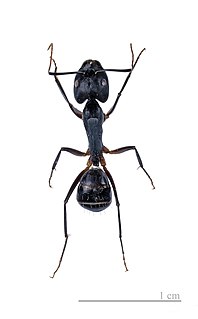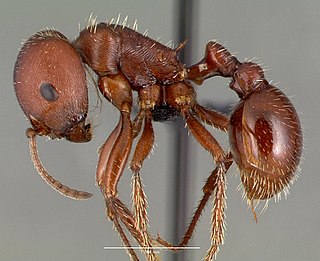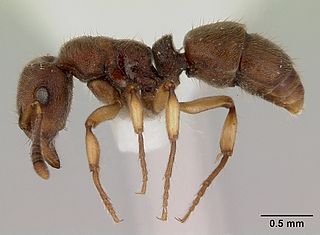
The Formicinae are a subfamily within the Formicidae containing ants of moderate evolutionary development.

Ponerinae is a subfamily of ants in the Poneromorph subfamilies group, with about 1,600 species in 47 extant genera, including Dinoponera gigantea - one of the world's largest species of ant. Mated workers have replaced the queen as the functional egg-layers in several species of ponerine ants. In such queenless species, the reproductive status of workers can only be determined through ovarian dissections.

Myrmicinae is a subfamily of ants, with about 140 extant genera; their distribution is cosmopolitan. The pupae lack cocoons. Some species retain a functional sting. The petioles of Myrmicinae consist of two nodes. The nests are permanent and in soil, rotting wood, under stones, or in trees.

Pogonomyrmex is a genus of harvester ants, occurring primarily in the deserts of North, Central, and South America, with a single endemic species from Haiti.

Dolichoderinae is a subfamily of ants, which includes species such as the Argentine ant, the erratic ant, the odorous house ant, and the cone ant. The subfamily presents a great diversity of species throughout the world, distributed in different biogeographic regions, from the Palearctic, Nearctic, Afrotropical region and Malaysia, to the Middle East, Australian, and Neotropical regions.

Crematogaster is an ecologically diverse genus of ants found worldwide, which are characterised by a distinctive heart-shaped gaster (abdomen), which gives them one of their common names, the Saint Valentine ant. Members of this genus are also known as cocktail ants because of their habit of raising their abdomens when alarmed. Most species are arboreal. These ants are sometimes known as acrobat ants.

Crematogastrini is a tribe of myrmicine ants with 64 genera and 8 fossil genera.

Procryptocerus is a Neotropical genus of gliding ants, with the ability to "parachute" by steering their fall if they drop off of the tree they're on.

Dolichoderus is a genus of ants found worldwide.

Heteroponerinae is a subfamily of ants in the poneromorph subfamilies group containing three genera in one tribe. The subfamily was created in 2003 when Barry Bolton divided the Ponerinae subfamily into six subfamilies.

Nesomyrmex is a genus of ants in the subfamily Myrmicinae. The genus is distributed in the Neotropical, Afrotropical and Malagasy regions. Most species live in arid climates, but some are known from the rainforest. They nest in soil or in trees. Little is known about their biology.
Acanthognathus poinari is an extinct species of ant in the subfamily Myrmicinae known from a single possibly Miocene fossil found on Hispaniola. A. poinari is the first species of the ant genus Acanthognathus to have been described from fossils found in Dominican amber and is one of several species of Acanthognathus found in the Greater Antillies.
Acanthognathus brevicornis is a species of ant belonging to the Acanthognathus genus. Described in 1944 by Smith, M.R., the species is native to northwestern South America.
Acanthognathus laevigatus is a species of ant belonging to the Acanthognathus genus. Described in 2009 by Galvis & Fernández, the species is native to Colombia.
Acanthognathus lentus is a species of ant belonging to the Acanthognathus genus. Described in 1922 by Mann, the species is native to Central America and South America.
Acanthognathus ocellatus is a species of ant belonging to the Acanthognathus genus. Described in 1969 by Brown & Kempf, the species is native to South America.
Acanthognathus stipulosus is a species of ant belonging to the Acanthognathus genus. Described in 1969 by Brown & Kempf, the species is native to South America.

Acanthognathus teledectus is a species of ant belonging to the Acanthognathus genus. Described in 1969 by Brown & Kempf, the species is native to Central America.













